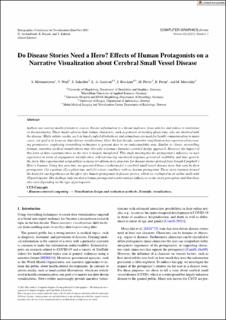| dc.description.abstract | Authors use various media formats to convey disease information to a broad audience, from articles and videos to interviews or documentaries. These media often include human characters, such as patients or treating physicians, who are involved with the disease. While artistic media, such as hand-crafted illustrations and animations are used for health communication in many cases, our goal is to focus on data-driven visualizations. Over the last decade, narrative visualization has experienced increasing prominence, employing storytelling techniques to present data in an understandable way. Similar to classic storytelling formats, narrative medical visualizations may also take a human character-centered design approach. However, the impact of this form of data communication on the user is largely unexplored. This study investigates the protagonist's influence on user experience in terms of engagement, identification, self-referencing, emotional response, perceived credibility, and time spent in the story. Our experimental setup utilizes a character-driven story structure for disease stories derived from Joseph Campbell's Hero's Journey. Using this structure, we generated three conditions for a cerebral small vessel disease story that vary by their protagonist: (1) a patient, (2) a physician, and (3) a base condition with no human protagonist. These story variants formed the basis for our hypotheses on the effect of a human protagonist in disease stories, which we evaluated in an online study with 30 participants. Our findings indicate that a human protagonist exerts various influences on the story perception and that these also vary depending on the type of protagonist. | en_US |

